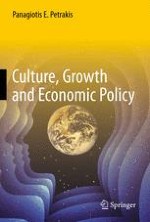2014 | OriginalPaper | Chapter
10. Power Distance, Uncertainty, Time and Growth
Author : Panagiotis E. Petrakis
Published in: Culture, Growth and Economic Policy
Publisher: Springer Berlin Heidelberg
Activate our intelligent search to find suitable subject content or patents.
Select sections of text to find matching patents with Artificial Intelligence. powered by
Select sections of text to find additional relevant content using AI-assisted search. powered by
